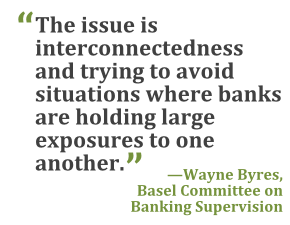Denmark's government said its proposals from May to easeBasel III liquidity rules will probably prevail when theEuropean Commission reveals its final decision on the matter thismonth.
|In an interview yesterday in Copenhagen, Economy MinisterMargrethe Vestager said she sees “no reason to believe there areany changes to the proposal” published by her ministry lastmonth.
|Denmark, which has spent the past three and a half yearsbattling rules by the Basel Committee on Banking Supervision thatthe nation says penalize its home finance system, is telling itsbanks they won't need to follow the global regulator's standardsfor covered bonds. Vestager said in May her ministry had receivedassurances from Brussels that Denmark's needs would be taken intoaccount when Europe adapts Basel III to its own markets.
|The government in Copenhagen has argued that applying the Baselrules, which limit the asset classes banks can use to fillliquidity reserves, would force lenders in the Nordic country tosell covered bonds. The Danish mortgage industry says there aren'tenough government bonds—favored under Basel—to fill the gap,because the AAA-rated nation doesn't have enough public debt. Bankscurrently use mortgage-backed covered bonds to meet about 70percent of their liquidity needs, versus a 40 percent cap set byBasel.
| Denmark said last month that the European Commission willrecommend letting banks hold 75 percent more in covered bonds thanBasel III rules allow. Though the commission still has until June30 to reveal its final decision, the development marks a victoryfor Denmark, which doesn't hold a seat on the 27-member Baselcommittee.
Denmark said last month that the European Commission willrecommend letting banks hold 75 percent more in covered bonds thanBasel III rules allow. Though the commission still has until June30 to reveal its final decision, the development marks a victoryfor Denmark, which doesn't hold a seat on the 27-member Baselcommittee.
Banks will be allowed to book the most liquid covered bonds at93 percent of their market value, compared with Basel's target of85 percent, according to Denmark's economy ministry. Lenders willalso be free to use the bonds for as much as 70 percent of theirliquidity buffers. The plan applies to all European covered bondsthat meet “certain criteria,” according to the ministry, whichcited a European Union (EU) commission proposal that Brussels hasyet to publish.
|To be included in the top liquidity bracket, covered bonds mustcarry a high credit rating and be issued in sizes of at least 500million euros (US$681 million), the ministry said. The bonds alsoneed to be over-collateralized, it said.
|Basel III rules had reserved the top liquidity status for bondssold by governments, even those bailed out during Europe's debtcrisis. The so-called Level 1 designation allowed banks to holdunlimited stores of sovereign debt at market value.
|Basel Clashes
|Denmark's insistence on shaping Basel rules to protect its $550billion mortgage-bond market, the world's largest per capita, hasmet some resistance.
|The European Union's implementation of Basel bank rules already“deviates on some important points” from international standards,Karel Lannoo, chief executive officer of the Centre for EuropeanPolicy Studies in Brussels, said by telephone in May. “These arenot details; these are essential issues,” he said. “This latestexample is no reassurance whatsoever.”
||Like other governmental bodies, the EU is under scrutiny fromthe Basel committee on how well it implements the group'srules.
|This has already led to one clash, after a preliminaryinternational assessment published in October 2012 found that EUplans on bank capital “departed from the Basel framework in manyareas.”
|The findings were challenged by Michel Barnier, the EU'sfinancial services chief, who said that the Basel report didn't“appear to be supported by rigorous evidence and a well-definedmethodology.”
|At Basel, the view is that allowing covered bonds to counttowards the liquidity coverage ratio was a “concession” to theasset class, according to Wayne Byres, the committee's secretarygeneral.
|“It's not about denying that they're liquid,” he said in aninterview in the Swiss city last week. “The issue isinterconnectedness and trying to avoid situations where banks aresimply holding large exposures to one another. Because then in asystemic crisis, the contagion can become much, much worse much,much faster than it might otherwise do.”
|Making Exceptions
|The Commission is set to present its final proposal by the endof June, which would then be sent for review by governments and theEuropean Parliament.
|Under the Basel standard, “for countries that otherwise have ashortage of high-quality liquid assets [HQLA], there are optionsbuilt into the rules,” Byres said. “One is an expanded use of level2 assets, which would include greater use of covered bonds. So,it's not as though it was entirely ruled out. It's allowable ifthere aren't enough HQLA assets around.”
|The Liquidity Coverage Ratio is due to fully apply in the EUfrom 2018, one year ahead of the Basel deadline of 2019.
|Barnier said May 20 he's seeking a “pragmatic and at the sametime rigorous” solution to the treatment of Danish covered bonds.“I think we will find a solution,” he said.
|Copyright 2018 Bloomberg. All rightsreserved. This material may not be published, broadcast, rewritten,or redistributed.
Complete your profile to continue reading and get FREE access to Treasury & Risk, part of your ALM digital membership.
Your access to unlimited Treasury & Risk content isn’t changing.
Once you are an ALM digital member, you’ll receive:
- Critical Treasury & Risk information including in-depth analysis of treasury and finance best practices, case studies with corporate innovators, informative newsletters, educational webcasts and videos, and resources from industry leaders.
- Exclusive discounts on ALM and Treasury & Risk events.
- Access to other award-winning ALM websites including PropertyCasualty360.com and Law.com.
*May exclude premium content
Already have an account? Sign In
© 2024 ALM Global, LLC, All Rights Reserved. Request academic re-use from www.copyright.com. All other uses, submit a request to [email protected]. For more information visit Asset & Logo Licensing.







